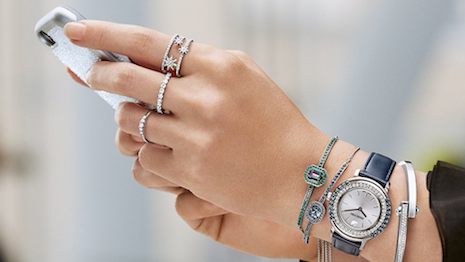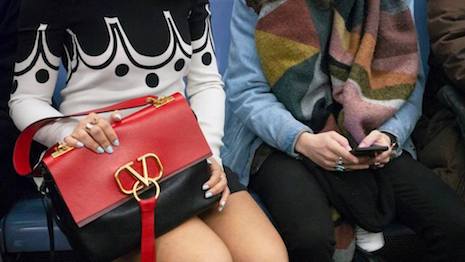 Almost 80 percent of mobile shopping sessions come from unpaid sources. Image credit: Swarovski
Almost 80 percent of mobile shopping sessions come from unpaid sources. Image credit: Swarovski
More than half of online traffic to fashion retailers comes from mobile devices, but an overwhelming majority of views come from unpaid sources.
According to a new “Fashion Retail on the Go” report from ecommerce platform Nosto, the average order value (AOV) for paid and unpaid mobile shopping conversions is about the same. While conversion rates on social networks may be lower than expected, these platforms still hold value as discovery channels.
“When it comes to the last step before arriving on a retailers’ site, online shopping in fashion is still a predominantly a search-driven business – but not just Google,” said Jim Lofgren, CEO of Nosto, New York. “A large chunk of traffic is certainly driven by shoppers ending up on retailers’ sites by searching for individual products or specific brands in Google, but another important chunk is consumers going directly to retailers they trust and searching for relevant products directly.
“We are seeing the fragmentation between the discovery and purchase funnels in action via the data,” he said. “Consumers are discovering brands and products through a variety of means – much of it in fashion on Instagram – but when they want to purchase those products or research them further, the consumer relies on Google or direct navigation to known retailers’ sites.”
Nosto’s report was based on a sample of almost 1.2 billion visits to Nosto-powered online stores between November 2018 and January 2019, including paid and unpaid shopping sessions. Nosto used last-click attribution for its analysis.
Sourcing shoppers
Mobile shoppers account for 62 percent of traffic to online fashion retailers. Seventy-nine percent of all mobile shopping sessions come from unpaid sources, such as searches or direct traffic without referral data.
Unpaid mobile shoppers account for 83 percent of all online fashion sales, for an average conversion rate of 1.79 percent and an AOV of $73. Shoppers from paid traffic, such as online ads, have a conversion rate of 1.31 percent and an AOV of $74.
 Instagram is a significant source of mobile shopping traffic. Image credit: Valentino
Social networks, including Instagram and Pinterest, are a significant traffic source of mobile shoppers.
Facebook-owned Instagram has respective conversion rates of 0.54 percent and 1.00 percent for paid and unpaid shopping sessions among all fashion retailers. However, when looking at enterprise fashion retailers, the paid conversion rate dips and the unpaid conversion rate increases.
Furthermore, Instagram has an AOV of more than $100 for paid sessions on enterprise fashion retailers, compared to an AOV of $72 for paid sessions on all fashion ecommerce sites.
Among enterprise fashion retailers, those who generate more than $50 million in annual online sales, less than 15 percent of sales and orders are attributed to paid shopping sessions. However, these sessions have a slightly higher AOV, $78 compared to $73 AOV for unpaid shopping sessions.
Although Pinterest trails other social networks in terms of traffic, sales and conversion rates among paid and unpaid sessions, its AOV of $140 is the highest across all channels.
Instagram is a significant source of mobile shopping traffic. Image credit: Valentino
Social networks, including Instagram and Pinterest, are a significant traffic source of mobile shoppers.
Facebook-owned Instagram has respective conversion rates of 0.54 percent and 1.00 percent for paid and unpaid shopping sessions among all fashion retailers. However, when looking at enterprise fashion retailers, the paid conversion rate dips and the unpaid conversion rate increases.
Furthermore, Instagram has an AOV of more than $100 for paid sessions on enterprise fashion retailers, compared to an AOV of $72 for paid sessions on all fashion ecommerce sites.
Among enterprise fashion retailers, those who generate more than $50 million in annual online sales, less than 15 percent of sales and orders are attributed to paid shopping sessions. However, these sessions have a slightly higher AOV, $78 compared to $73 AOV for unpaid shopping sessions.
Although Pinterest trails other social networks in terms of traffic, sales and conversion rates among paid and unpaid sessions, its AOV of $140 is the highest across all channels.
 Pinterest has the highest AOV among social networks. Image credit: Pinterest
Pinterest is continuing to make itself useful to luxury marketers and retailers with more commerce offerings. New features such as full catalogs, personalized shopping recommendations and shopping search aim to bring Pinterest closer to becoming an interactive retail platform (see story).
“There’s something that is potentially really interesting here that Pinterest can look to capitalize as it IPOs and continues to grow,” Mr. Lofgren said.
Looking ahead
While Facebook falls behind search and other social networks in terms of sales and AOV, it remains an important channel for fashion marketers.
Despite marketers’ recent emphasis on social media platform Instagram, its sister network Facebook is actually the top digital channel to discover new brands.
According to Criteo’s “Why We Buy” survey, brand Web sites were the second most popular discovery channel and were cited by 46 percent of respondents compared to Facebook’s 49 percent. While almost half of shoppers found new brands through Facebook, only 27 percent of respondents said they discovered new brands through Instagram (see story).
Meanwhile, shopping metrics for Instagram are likely to change with the advent of its Checkout feature.
Several luxury brands are among the first to roll out Instagram Checkout, including Dior and Prada. Instagram has now eliminated the step of visiting a retailer’s Web site through its mobile application, and has instead created its own checkout process (see story).
“Luxury fashion brands can use our data to benchmark themselves in terms of how much traffic they’re driving from paid versus unpaid sources, and whether or not they’re utilizing social channels in similar ways to their peers,” Nosto’s Mr. Lofgren said. “Particularly for luxury brands that are spending a lot of money on brand-oriented advertising and have challenges in determining proper attribution, they can see if they are over-indexed or under-indexed in the percentage of search or direct traffic that is potentially driven by these investments.”
Pinterest has the highest AOV among social networks. Image credit: Pinterest
Pinterest is continuing to make itself useful to luxury marketers and retailers with more commerce offerings. New features such as full catalogs, personalized shopping recommendations and shopping search aim to bring Pinterest closer to becoming an interactive retail platform (see story).
“There’s something that is potentially really interesting here that Pinterest can look to capitalize as it IPOs and continues to grow,” Mr. Lofgren said.
Looking ahead
While Facebook falls behind search and other social networks in terms of sales and AOV, it remains an important channel for fashion marketers.
Despite marketers’ recent emphasis on social media platform Instagram, its sister network Facebook is actually the top digital channel to discover new brands.
According to Criteo’s “Why We Buy” survey, brand Web sites were the second most popular discovery channel and were cited by 46 percent of respondents compared to Facebook’s 49 percent. While almost half of shoppers found new brands through Facebook, only 27 percent of respondents said they discovered new brands through Instagram (see story).
Meanwhile, shopping metrics for Instagram are likely to change with the advent of its Checkout feature.
Several luxury brands are among the first to roll out Instagram Checkout, including Dior and Prada. Instagram has now eliminated the step of visiting a retailer’s Web site through its mobile application, and has instead created its own checkout process (see story).
“Luxury fashion brands can use our data to benchmark themselves in terms of how much traffic they’re driving from paid versus unpaid sources, and whether or not they’re utilizing social channels in similar ways to their peers,” Nosto’s Mr. Lofgren said. “Particularly for luxury brands that are spending a lot of money on brand-oriented advertising and have challenges in determining proper attribution, they can see if they are over-indexed or under-indexed in the percentage of search or direct traffic that is potentially driven by these investments.”
